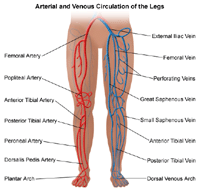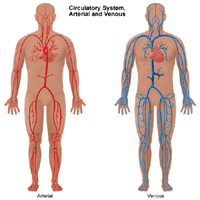Peripheral Artery Disease
What is peripheral artery disease (PAD)?
Peripheral artery disease (PAD) is a slow and progressive circulation disorder affecting the arteries that supply the legs or arms and is usually caused by atherosclerosis. It may involve disease in any of the arteries outside of the heart.
 |
| Click Image to Enlarge |
The terms "peripheral vascular disease" and "peripheral artery disease" are often used interchangeably. In the US, about 10 million people have peripheral artery disease. It is frequently found in people with coronary artery disease, because atherosclerosis, which causes coronary artery disease, is a widespread disease of the arteries.
 |
| Click Image to Enlarge |
Conditions associated with PAD may be occlusive (occurs because the artery becomes blocked in some manner) or functional (the artery either constricts due to a spasm or expands). Examples of occlusive PAD include peripheral arterial occlusion and Buerger's disease (thromboangiitis obliterans).
What causes peripheral artery disease?
PAD is characterized by a narrowing of the vessels that carry blood to the leg and arm muscles. The most common cause is atherosclerosis (the buildup of plaque inside the artery wall). Plaque reduces the amount of blood flow to the limbs and decreases the oxygen and nutrients available to the tissue. Clots may form on the artery walls, further decreasing the inner size of the vessel and potentially blocking off major arteries.
 |
| Click Image to Enlarge |
Other causes of peripheral vascular disease may include trauma to the arms or legs, irregular anatomy of muscles or ligaments, or vasculitis. Persons with coronary artery (arteries that supply blood to the heart muscle) disease are frequently found to also have peripheral artery disease.
What are conditions associated with peripheral artery disease?
The most common condition associated with PAD is:
-
atherosclerosis - the build-up of plaque inside the artery wall. Plaque is made up of deposits of fatty substances, cholesterol, cellular waste products, calcium, and fibrin. The artery wall then becomes thickened and loses its elasticity. Symptoms may develop gradually, and may be few, as the plaque builds up in the artery. However, when a major artery is blocked, a heart attack, stroke, aneurysm, or blood clot may occur, depending on where the blockage occurs.
A less common condition is:
-
Buerger's disease (thromboangiitis obliterans) - a chronic inflammatory disease in the peripheral arteries of the extremities leading to the development of clots in the small- and medium-sized arteries of the arms or legs and eventual blockage of the arteries. Buerger's disease most commonly occurs in men between the ages of 20 and 40 who smoke cigarettes. Symptoms include pain in the legs or feet, clammy cool skin, and a diminished sense of heat and cold.
What are the risk factors for peripheral artery disease?
A risk factor is anything that may increase a person's chance of developing a disease. It may be an activity, diet, family history, or many other things. Risk factors for peripheral artery disease include factors which can be changed or treated and factors that cannot be changed.
Risk factors that cannot be changed include the following:
-
age (especially older than 70)
-
history of coronary artery disease
-
diabetes mellitus
-
history of cigarette smoking or use of tobacco products
Risk factors that may be changed or treated include:
Those who smoke or have diabetes mellitus have the highest risk of complications from peripheral artery disease because these risk factors also cause impaired blood flow.
What are the symptoms and signs of peripheral artery disease?
Approximately half the people diagnosed with peripheral artery disease are symptom free. For those experiencing symptoms, the most common first symptom is intermittent claudication in the calf (leg discomfort described as painful cramping that occurs with exercise and is relieved by rest). During rest, the muscles need less blood flow, so the pain disappears. It may occur in one or both legs depending on the location of the clogged or narrowed artery.
Other symptoms of peripheral artery disease may include:
-
diminished pulses in the legs and the feet
-
non-healing wounds over pressure points, such as heels or ankles
-
numbness, weakness, or heaviness in muscles when walking
-
pain in the toes or feet often at night while lying flat
-
gangrene (dead tissue due to lack of blood flow)
The symptoms of peripheral artery disease may resemble other conditions. Consult your physician for a diagnosis.
How is peripheral artery disease diagnosed?
In addition to a complete medical history and physical examination, diagnostic procedures for peripheral artery disease may include any, or a combination, of the following:
-
ankle-brachial index (ABI) - a comparison of the blood pressure in the ankle with the blood pressure in the arm using a regular blood pressure cuff and a Doppler ultrasound device. To determine the ABI, the systolic blood pressure (the top number of the blood pressure measurement) of the ankle is divided by the systolic blood pressure of the arm.
-
segmental blood pressure measurements - a means of comparing blood pressure measurements using a Doppler device in the upper thigh, above and below the knee, at the ankle, and on the arm to determine any constriction in blood flow.
-
pulse volume recording (PVR) waveform analysis - a technique used to calculate blood volume changes in the legs using a recording device that displays the results as a waveform.
-
treadmill exercise test - a test that is given while a patient walks on a treadmill to monitor the heart during exercise.
-
Doppler ultrasound flow studies - uses high-frequency sound waves and a computer to create images of blood vessels, tissues, and organs. Doppler technique is used to measure and assess the flow of blood. Faintness or absence of sound may indicate an obstruction in the blood flow.
-
magnetic resonance angiography (MRA) - a noninvasive diagnostic procedure that uses a combination of a large magnet, radiofrequencies, and a computer to produce detailed images of organs and structures within the body. An MRA is often used to examine the heart and other soft tissues and to assess blood flow.
What is the treatment for peripheral artery disease?
There are two main goals for treatment of peripheral artery disease: control the symptoms and halt the progression of the disease to lower the risk of heart attack, stroke, and other complications.
Specific treatment will be determined by your physician based on:
-
your age, overall health, and medical history
-
extent of the disease
-
your signs and symptoms
-
your tolerance for specific medications, procedures, or therapies
-
expectations for the course of the disease
-
your opinion or preference
Treatment may include:
-
lifestyle modifications to control risk factors, including regular exercise, proper nutrition, and smoking cessation
-
aggressive treatment of existing conditions that may aggravate PAD, such as diabetes, hypertension, and hyperlipidemia (elevated blood cholesterol)
-
antiplatelet agents such as aspirin
-
medications for improving blood flow, such as cilostazol
-
angioplasty - a catheter (long hollow tube) is used to create a larger opening in an artery to increase blood flow. Angioplasty may be performed in many of the arteries in the body. There are several types of angioplasty procedures, including:
-
balloon angioplasty - a small balloon is inflated inside the blocked artery to open the blocked area
-
stent - a tiny coil is expanded inside the blocked artery to open the blocked area and is left in place to keep the artery open
-
atherectomy - the blocked area inside the artery is "shaved" away by a tiny device on the end of a catheter
-
vascular surgery - a bypass graft using a blood vessel from another part of the body or a tube made of synthetic material is placed in the area of the blocked or narrowed artery to reroute the blood flow
With both angioplasty and vascular surgery, an angiogram is often performed prior to the procedure.
What are the complications of peripheral artery disease?
Patients with PAD are at increased risk of heart attack and stroke. Complications of peripheral artery disease include:
-
amputation (loss of a limb)
-
poor wound healing
-
restricted mobility due to pain or discomfort with exertion
-
severe pain in the affected extremity
By following an aggressive treatment plan for peripheral artery disease, complications such as these may be prevented.
Prevention of peripheral artery disease:
Steps to prevent PAD are primarily aimed at management of the risk factors for PAD. A prevention program for PAD may include:
-
dietary modifications including reduced fat, cholesterol, and simple carbohydrates (such as sweets), and increased amounts of fruits and vegetables
-
smoking cessation, including avoidance of second hand smoke and use of tobacco products
-
treatment of dyslipidemia (high blood cholesterol levels) with medications as determined by your physician
-
weight reduction
-
medications as determined by your physician to reduce your risk of blood clot formation
-
exercise plan of a minimum of 30 minutes daily
-
control of diabetes mellitus
-
control of hypertension (high blood pressure)
A prevention plan for PAD may also be used to prevent or lessen the progress of PAD once it has been diagnosed. Consult your physician for diagnosis and treatment.
Click here to view theOnline Resources of Cardiovascular Disease